HENDI 272411 LOUNGE HEATER
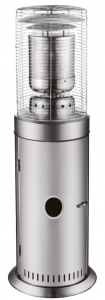
Safety regulations
- This appliance must be used outdoors or in a well ventilated area, and should not be installed or used indoors.
- Change the gas cylinder in a well ventilated area, away from any inflammation sources.
- The cylinder must be stored outdoors or in a well ventilated area.
- Storage this appliance indoors is permissible only if gas cylinder is disconnected and removed from the appliance.
- Do not move this appliance when in operation, or after it has been turned off before the temperature has cooled down.
- Do not attempt to alter the appliance in any manner. Do not paint the radiant screen, control panel or reflector.
- Do not obstruct the ventilation holes of the cylinder housing.
- The appliance must be installed and gas cylinder stored in accordance with local gas fitting regulations.
- Shut off the valve at the gas cylinder or the regulator before moving the appliance.
- Use only the type of gas specified by the manufacturer.
- Repairs should be done by a qualified person.
- In case of violent wind, particular attention must be taken against tilting of the appliance.
- Check that the regulator seal is correctly fitted and able to fulfil its function.
- Close the gas supply at the valve of the gas cylinder or the regulator after use.
- Do not use this appliance until all connections have been leak tested.
- In the event of gas leakage, the appliance shall not be used or if alight, the gas supply shall be shut off and the appliance shall be investigated and rectified before it is used again.
- Checking the tubing or the flexible hose per month and each time the cylinder is changed.
- The tubing or the flexible hose must be changed within the prescribed intervals or within one year. The flexible hose should not extended than 1.5m according to standard EN16436:2014.
- The hose assembly must be replaced prior to the appliance being put into operation if there is evidence of excessive abrasion or wear, or if the hose is damaged, and that the replacement hose assembly shall be that specified by the manufacturer.
- The heater should be inspected before use and at least annually by a qualified service person. More frequent cleaning may be required as necessary. It is imperative that control compartment, burners and circulating air passageways of the appliance be kept clean.
- Shut off and check heater immediately if any of the following conditions exist:– The smell of gas in conjunction with extreme yellow tipping of the burner flames.– Heater does not reach a proper temperature. A temperature less than 5ºC will cause restricted heat flow and the appliance will not work properly.– The appliance starts making popping noises during use (a slight popping noise is normal when the appliance is extinguished).
- The regulator & hose assembly must be located out of pathways where people may trip over it or in area where the hose will not be subject to accidental damage.
- Any guard or other protective device removed for servicing the heater must be replaced before operating the heater.
- Children and adults should be warned of the hazards of high surface temperatures and should stay away to avoid burns or clothing ignition.
- Young children and pets should be carefully supervised when they are in the area of the heater.
- Clothing or other flammable materials should not be hung from the appliance, or placed on or near the appliance.
- Do not place articles on or against this appliance. Certain material or items when stored under or near this appliance will be subjected to radiant heat and could be seriously damaged.
- Do not use or store flammable materials near this appliance.
- Do not spray aerosols in the vicinity of this appliance while it is in operation.
- Always maintain at least 0.9m clearance from combustible materials.
- Always position the appliance on a firm level surface. An amply ventilated area must have a minimum of 25% of the surface area open. The surface area is the sum of the walls surface.
- The injector in this appliance is not removable and the injector is only assembled by manufacture. This appliance is forbidden to convert from one gas pressure to another pressure.
- Do not connect the gas cylinder directly to the appliance without regulator.
- The gas cylinder must be fixed by cylinder belt, which is inside the housing, while installation.
Intended use
- The device is intended for professional use and can be operated only by qualified personnel.
- The appliance is designed only for heating outdoors or well ventilated areas. Any other use may lead to damage to the appliance or personal injury.
- Operating the appliance for any other purpose shall be deemed a misuse of the device. The user shall be solely liable for improper use of the device.
Part list
|
PART NO. |
PART NAME |
QTY |
| 1 | Grid (left) | 1 |
| 2 | Double head bolt A | 6 |
| 3 | Double head bolt B | 4 |
| 4 | Grid (right) | 1 |
| 5 | Refl ector A | 1 |
| 6 | Reflector B | 1 |
| 7 | Emitter | 1 |
| 8 | Whole bur ner assembly | 1 |
| 9 | Hand le | 1 |
| 10 | Rear housing | 1 |
| 11 | Door | 1 |
| 12 | Wheels | 1 |
| 13 | Base | 1 |
Exploded view

Assembly
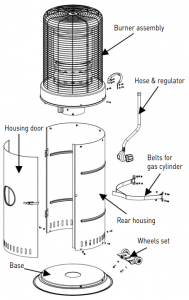
Tools required: Philips head screwdriverNote: Remove any transit protection material before assembly.Step 1: Place the base on a flat surface. Secure the rear housing to the base using 5pcs M5*10 screws and washers.Step 2: Secure The burner assembly outside of the rear housing using 5pcs M5*10 screws and washers.ATTENTION: To close the door well, lift the burner assembly by one hand to secure 5pcs M5*10 screws and washers with the lowest position of screw holes in burner assembly.Step 3: Connecting hose & regulator to the burner assembly.Put gas cylinder on the base and connecting regulator to a gas cylinder, then assembly 2 cylinder belts and ensure gas cylinder using belts. (See “Connecting to a Gas Cylinder” and “Securing a Gas Cylinder”) Check leakage for all connections using a soapy water solution. (See “Gas Leakage Test”)Step 4: Slide the housing door onto the hinge of rear housing, close door and lock.Step 5: Attach wheels set to the base with 2pcs M6*12 screws and washers. (Ignore this step in case wheels set is assembled).
Gas requirements
- The appliance must use an EN12864 approved gas regulator and CE approved gas hose with a length of 0.5meter (BS3212 and EN1763-1).
- Never use a gas cylinder with a damaged body, valve, collar, or foot ring. A dented or rusty gas tank may be hazardous and should be checked out by a gas supplier.
- Never connect this appliance to an unregulated gas source.
- When the appliance is not in use, turn the gas cylinder OFF.
- Always perform a leak test on gas connections whenever a cylinder is connected. If bubbles form in the leak test solution, do not use. Never use a flame to test for leaks.
Connecting to a gas cylinder
- Refer to your gas supplier for instructions on the use of your gas cylinder.
- Approved gas regulator is used according to appliances categories and countries listed in data plate. Approved flexible hose would be changed when the national conditions require it & consult the local regulations, these may differ.
- Warning: assembly of the tubing must be conducted by some qualified tuber of destination countries.
- Only change gas cylinders outdoors or in a well ventilated area away from naked flames and any other source of ignition.
- The gas cylinder must always be used in an upright position.
- Close the heater control knob by turning fully clockwise.
- Close the gas cylinder tap and then attach the regulator onto the gas cylinder.
- Tighten all connections firmly and with a spanner where appropriate. The cylinder should be located on the cylinder base.
- The gas cylinder must be fixed by cylinder belt, which is inside the housing, while installation.
- Check for leaks at all joints using soapy water. If a leak is found, tighten the joint and then re-test.
Securing a gas cylinder

- Fix both cylinder restraint straps onto the rear tank housing using 4pcs M5x12 bolts with M5 washer and M5 nuts.
- Position a gas cylinder inside the tank housing.
- Connect the gas cylinder with a regulator. Please refer to the instructions attached with the regulator on how to connect a regulator with the gas cylinder.
- Stick cylinder restraint straps together as above photo illustrated. The straps must be in a proper tightness for the gas cylinder.
Caution: Please take care that the cylinder restraint straps. DO NOT strain the regulator assembly
Minimum clearance from combustible materials
Important safety rules

For use outdoors or in amply ventilated areas.An amply ventilated area must have a minimum of 25% of the surface area open.The surface area is the sum of the walls surface.The use of this appliance in enclosed areas can be dangerous and is PROHIBITED.Children and adults should be aware of the high operating temperatures of areas above the post when operating this heater. Children should be carefully supervised when in the vicinity of the heater.NEVER hang anything, including clothes or any other flammable items, on this heater.DO NOT operate this heater unless it is fully assembled with its reflector in place.Respect the minimum clearances from combustible materials.
Gas leakage test
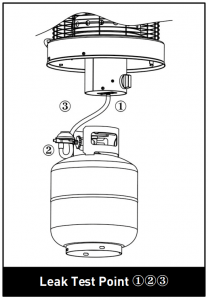
Never use a naked flame to check for leaks. Never leak test while smoking.The gas connections on this appliance are leak tested at the factory prior to shipment.This appliance needs to be periodically checked for leaks and an immediate check is required if the smell of gas is detected.
- Make a soap solution using 1 part of liquid dish-washing soap to 3 parts water. The soap solution can be applied with a soap bottle, brush, or rag to the leak tested points shown in the figure above.
- The valve of the gas cylinder should be in the OFF position at this point of the leak test. Once the soapy solution is applied to the gas connections, the valve of the gas cylinder needs to be turned to the ON position.
- Soap bubbles will begin to form in the soapy solution if a leak is present.
- In case of a leak, turn off the gas supply. Tighten any leaking fittings, then turn the gas supply on and recheck.
Lighting instructions
Before first use and after every gas cylinder change, gas delivery system must be purged of air before igniting! To do this, turn the control knob anticlockwise to the pilot setting. Press knob in and hold for 3 minutes before attempting ignition.
- Check all gas connections prior to use.
- Turn on gas supply at source.
- Press to turn control knob anticlockwise to ‘IGNITITION (PILOT)’.
- Hold knob depressed until pilot flame is lit, then continue to hold the knob depressed for 20 seconds until the pilot remains lit after releasing knob.
- If pilot fails to ignite or remain alight, press to turn knob clockwise to ‘OFF’ and repeat.
- The pilot should be lit & the knob set to ‘PILOT’.
- Hold knob depressed gently & turn anticlockwise to ‘LOW’ or “HIGH” as desired.
To Extinguish
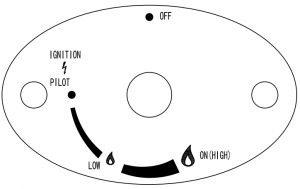
- Hold knob depressed & turn the knob clockwise to “OFF”.
- Close the valve of the gas cylinder or the regulator after use.
- Allow this appliance to cool before moving
Maintenance & servicing
To enjoy years of outstanding performance from your heater, make sure you perform the following maintenance activities on a regular basis:
- Keep exterior surfaces clean.
- Use warm soapy water for cleaning. Never use flammable or corrosive cleaning agents.
- While washing your unit, be sure to keep the area around the burner and pilot assembly dry at all times. If the gas control is exposed to water in any way, DO NOT try to use it. It must be replaced.
- Airflow must be unobstructed. Keep controls, burner and circulation air passageways clean.Signs of possible blockage include:– Gas odor with extreme yellow tipping of flame.– Heater does NOT reach the desired temperature.– Heater glow is excessively uneven.– Heater makes popping noises.
- Spiders and insects can nest in burner or orifices. This dangerous condition can damage the heater and render it unsafe for use. Clean burner holes by using a heavy duty pipe cleaner. Compressed air may help clear away smaller particles.
- Carbon deposits may create a fire hazard. If any carbon deposits develop, clean dome and engine with warm soapy water
Note: in a salt-air environment (such as near the sea), corrosion occurs more quickly than normal. Frequently check the corroded areas and repair them promptly.
Servicing
- Please consult your local dealer for servicing this appliance and replacement of its parts. The servicing of the appliance shall be carried out only by authorised personnel.
- Caution: do not use unauthorized parts or components for this appliance, only use original equipment replacement parts and components. The use of unauthorized parts or components will void the warranty and can create an unsafe condition.
Note
- It is recommended to replace the gas hose after 3 or 4 years (see date shown on hose). The gas hose becomes porous after a time. Also check the hose for leaks on a yearly basis at least. Even if the expiration date has not been expired yet, you must check the condition of the hose always. In case of damage/cracks you have to replace the hose immediately. Please make sure that you comply with all local health and safety regulations (e.g. fire code).
- Pressure regulators have a default maximum life span as indicated by the date printed on the regulator, but please note that local health and safety regulations may overrule this.
- Only replace the pressure regulator with one provided by the manufacturer.
- Consult the local regulations, these may differ.
- Always store gas bottles upright, in use as well as when empty
Storage
There is no limitation on the storage of the appliance indoors provided that the cylinder is removed from the appliance. Between uses:
- Turn control knob OFF
- Turn gas cylinder OFF
Store heater upright in an area sheltered from direct contact with inclement weather (such as rain, sleet, hail, snow, dust and debris).If desired, cover to protect exterior surfaces and to prevent build up in air passages.Note: Wait until heater is cool before covering.
During periods of extended inactivity or when transporting:
- Turn control knob OFF.
- Disconnect gas cylinder and move to a secure, well ventilated location outdoors. DO NOT store in a location that will exceed 50°C.
Store heater upright in an area sheltered from direct contact with inclement weather (such as rain, sleet, hail, snow, dust and debris).If desired, cover heater to protect exterior surfaces and to prevent build up in air passages.Note: Wait until heater is cool before covering
Troubleshooting
| IF THE PROBLEM IS: | AND THIS CONDITION EXISTS: |
THEN DO THIS: |
| Pilot won’ t light | Cylinder valve is closed | Open valve |
| Blockage in orifice or pilot tube | Clean or replace orifice or pilot tube | |
| Air in the gas line | Open gas line and bleed it (pressing control knob in) for not more than 1-2 minutes or until you smell gas | |
| Low gas pressure | Gas cylinder low or empty | |
| Igniter fails | Use match to light pilot. and obtain new igniter and replace. (See below pictures) | |
| Pilot won‘ t stay lit | Dirt builds up around pilot | Clean dirt from around pilot |
| Connection between gas valve and pi- lot assembly is loose | Tighten connection and perform leak test | |
| Bad thermocouple | Replace thermocouple | |
| Burner worn | Gas pressure is low | Replace gas cylinder |
| Blockage in orifice | Clear blockage | |
| Control knob is not in “ON” position | Turn control knob to “ON” position | |
| Burner flame is lowNote: Do not operate heater below 5°C | Gas pressure is low | Replace gas cylinder |
| Outdoor temperature is greater than 5°C and tank is les s than 25% full. | Replace gas cylinder | |
| Supply hose is bent or kinked | Straighten hose and perform leak test on hose | |
| Control knob is fully ” ON” | Turn control knob to “OFF’, let it cool to room temperature & check burner and orifices for blockage | |
| Emitter glows unevenNote: Bottom 2.5cm of emitter normally does not normally glow | Gas pressure is low | Replace gas cylinder |
| Base is not on a level surface | Place heater on a level surface | |
| Heater not level | Level heater | |
| Carbon build-up | Dirt or film on reflector and emitter | Clean reflector and emitter |
| Thick black smoke | Blockage in burner | Turn control knob to “OFF’, let it cool to room temperature and remove blockage and clean burner inside and outside. |
Warning
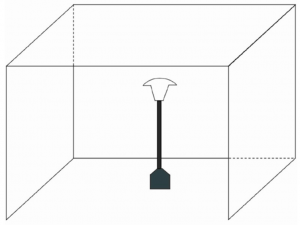
Read the instructions before using this appliance.The appliance must be installed in accordance with instructions and local regulations.The use of this appliance in enclosed areas can be dangerous and is PROHIBITED.For use outdoors or in amply ventilated areas. An amply ventilated area must have a minimum of 25% of the surface area open.The surface area is the sum of the walls surface.
Warranty
Any defect affecting the functionality of the appliance which becomes apparent within one year after purchase will be repaired by free repair or replacement provided the appliance has been used and maintained in accordance with the instructions and has not been abused or misused in any way.Your statutory rights are not affected. If the appliance is claimed under warranty, state where and when it was purchased and include proof of purchase (e.g. receipt).In line with our policy of continuous product development we reserve the right to change the product, packaging and documentation specifications without notice.
Discarding & Environment
When decommissioning the appliance, the product must not be disposed of with other household waste. Instead, it is your responsibility to dispose to your waste equipment by handing it over to a designated collection point.Failure to follow this rule may be penalized in accordance with applicable regulations on waste disposal. The separate collection and recycling of your waste equipment at the time of disposal will help conserve natural resources and ensure that it is recycled in a manner that protects human health and the environment.For more information about where you can drop off your waste for recycling, please contact your local waste collection company. The manufacturers and importers do not take responsibility for recycling, treatment and ecological disposal, either directly or through a public system.
|
|
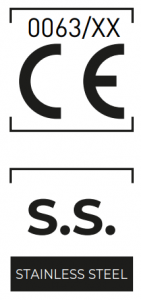 |
|||||
| Item | 272411 Lounge Heater | PIN : 0063CO7365 | ||||
| Country | NL/DE/AT/CH | NL/DE/AT/CH | AT/CH/HR | RO/IT/HU | CZ/SK | PL |
| Power | [HS] 8,5 kW | [HS] 7,5 kW | [HS] 10 kW | [HS] 7,5 kW | [HS] 7,5 kW | [HS] 8,5 kW |
| Category | I3P | I3P | I3B/P | I3B/P | I3+ | I3B/P |
| Consumption | 607 g/h | 536 g/h | 728 g/h | 546 g/h | G30: 546 g/h,G31: 536 g/h | 619 g/h |
| Set up | G31-50 mbar | G31-37 mbar | G30/31-50mbar | G30/31-30mbar | G30: 28-30 mbar,G31: 37 mbar | G30/31-37mbar |
| Serial no. |
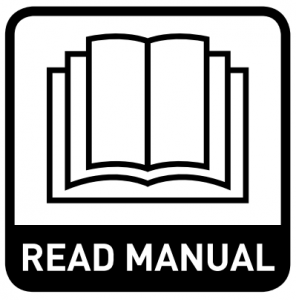 Keep these instructions with the appliance Keep these instructions with the appliance |
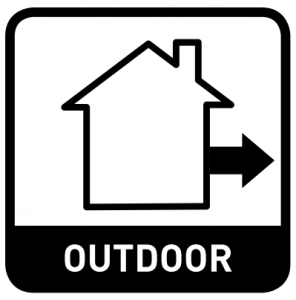 Use outdoors only Use outdoors only |
 |
Dear Customer,Thank you for purchasing this Hendi appliance. Please read this manual carefully before connecting the appliance in order to prevent damage due to incorrect use. Read the safety regulations in particular very carefully.

References
[xyz-ips snippet=”download-snippet”]

